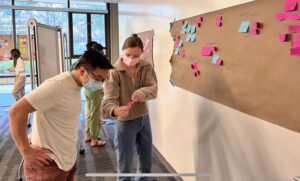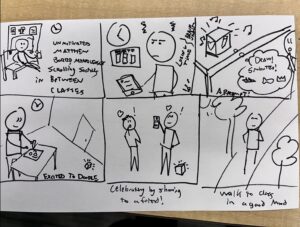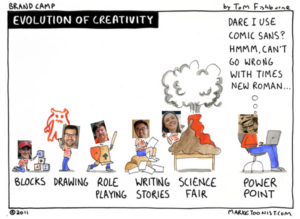What Did I Sign Up For??
When I signed up for this class, I was excited to take a course with design elements that wasn’t a part of the d school curriculum to see how other departments approach design pedagogy. Given the ‘behavior change’ title, I initially thought it would be a lot more about the incorporation of behavior science into product design – techniques for how to incorporate elements from research and books like Nudge or Thinking Fast & Slow. Already in week one, I was surprised at how much emphasis was actually being placed on sketchnoting, publication of work, and the user research and iteration process: I’d have to upload drawings of notes, and find participants for studies week after week?!
What I Got Out
That being said, I really enjoyed what this class ended up teaching me. Since I had never really done anything close to running a longitudinal study before, I was a bit intimidated by what it would entail. What I’ve learned is, I was right – designing and implementing a good user research study is difficult! However, even though they were chaotic to execute within the constraints of the quarter, I do now have a much greater appreciation for just what those kinds of studies entail in terms of planning and insight.
I found it especially helpful to have thoughtful readings each week that connected to the topics we would cover in class – from readings on how to sketchnote, to running studies, to exploring the complicated world of design ethics and justice. I also appreciated that we engaged in discussions of the readings in class, although I wasn’t always the biggest fan of how we did so. While I liked splitting up teams to get to talk to others in the class, it was sometimes awkward to try and cold-start discussions on the readings, even when we were given questions to help prompt us. I might have liked to see more large group general overviews of the readings in class after they were assigned to kickstart conversations before splitting into smaller groups. Even so, getting to engage in sometimes difficult and unsolvable ethics questions felt inspiring, and I really liked that these discussions were almost always grounded in real-world examples and applications.

I am always weary of group projects, especially in courses where I don’t know anyone beforehand. Luckily, I loved working with my group! I liked that a lot of the design activities and assignments were often well-suited to be divided and conquered (much like design work would be in the real world). Despite being a larger group with 5 people, I am very happy with how my team approached each step of the project – discussing exactly how we wanted to approach each activity, how we wanted to split it up, what our expectations were, and how well we collaborated when it came time to put things together. There was one moment in the quarter when I was worried that we all had too different ideas for what our final solution would look like – each of our storyboards took vastly different approaches. Thankfully, we resolved and converged on an approach, and in a satisfying way – not just a few people surrendering creative control to a few, but the team aligning on how various elements of our different ideas could fuse together to best align with our overarching goal. Even though our final solution did have some bits that felt frankenstein’ed together (stories AND galleries AND friends AND groups AND followers AND ????) I liked that we tried to justify each decision as a team and am ultimately proud of what we produced.
Other Challenges
There’s always challenges and woes, even with a good team. While it was cool to simulate what it would entail to do a longitudinal study and other experiments, the small amount of data we had due to the rushed and limited resource nature of it made it difficult to stand by the data on our design decisions, since the data came from only a handful of people.
I’m also super glad I was able to gain experience with digital prototyping in Figma! Part of me wished we had gotten more in-class instruction on using some of these digital design tools, but I think throwing myself into the fire and just figuring it out helped a lot in the end, because I now feel way more comfortable with the software, or at least in knowing how to search for what I don’t know how to do.
For me, the biggest thing that felt unresolved about our project would be to test the prototype live. It would be so cool to see how people would actually interact with creativity in groups. Right around week 10, I discovered that a friend of mine was using Slack with other design and art students to showcase projects they would make around the PRL. I was thrilled, because that was the closest to a real life instance of our project – fun reactions, lots of support and uplifting, and people engaging happily with sharing their creativity with each other. I wish we could have tried to deploy our project in some way to get even more user feedback!
Ethics & Inclusive Design

With ‘ethical issues’ being such a broad topic, I am thankful that the class discussed ethics in a more grounded and systematic way – guiding us through manipulation, privacy, universality, and well-being. Our project incorporated nudging in a more low-key way by putting emphasis on being able to see others’ work in the app. We added a stories feature at the top of the home screen, and the buttons to click into groups were prominently displayed and above the links leading to personal art. Our approach with this was to lean into the inspirational and social elements of our solution, but I do worry that we leaned too far and are at risk of creating another social media site where the above-and-beyond is portrayed as normal, which could negatively affect the types of users we want to attract.
Inclusive design is another main concern of mine. Given that our solution was centered around the concept of ~creativity~, something that is inherently expressed in very different ways on an individual basis, I was and am still concerned that our solution isn’t flexible enough for all types of users to engage with creativity on their own terms. What if the user only wants to work in private, or fears being exposed in some way through the social channels of the app? What if the app becomes a breeding ground for more insecurity, instead of less? What if users can’t engage with the types of art mediums we presented, or just don’t want to? These are questions that, while I appreciated that we at least thought about briefly, I wish we had more time to answer through robust testing, review, and conversation.
Conclusion

All in all, I really enjoyed the course, my team, our discussions, lectures, and getting great feedback from Christina and Medha. I have a much greater appreciation for the work that goes into the design of digital solutions, and an even greater appreciation for the fact that a lot of that work can and should be applied to all types of design, from research and ideation to prototyping and testing. I am excited to bring this training into more design work in the future, both in my other design classes, both physical and service design, and throughout my career.



